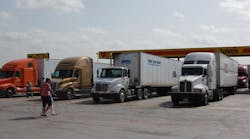Now that may seem a strange thing to highlight in the context of the rough-and-tumble freight hauling world, especially as by its very nature driving a truck means long hours spent alone away from friends and family. That appeals to certain folks, of course, but for many it doesn’t.
But can “job happiness” really trump pay when it comes to workplace trends – even for positions far less taxing that piloting big rigs down crowded highways and streets?
Well if a new survey conducted on behalf of staffing services firm Spherion is to be believed, that answer is “yes,” though pay and health benefits remain critical piece of “job happiness” calculations.
According to the second annual WorkSphere survey, conducted by Harris Poll on behalf of Spherion among employed adults, in addition to compensation being a factor in determining job happiness (22%), about one-fifth of workers reported that it's important they work in a field that they are interested in and passionate about (19%).Job security (15%), the company's culture/work environment (13%) and the ability to work with people they like (10%) were ranked almost equally as high among workers. Yet factors such as workplace flexibility (7%), the ability to work with people they work well with (6%) and opportunities for career advancement (5% were reported as less significant when it comes to job happiness.
Additionally, workers will go to various lengths when accepting a new job for the sake of being happier in their careers. Workers would be at least somewhat willing to work in a less private office space (76%), reduce their workplace flexibility (60%) and even accept a lower position or title (60%). And almost half of all workers will give up benefits such as their vacation time, 401K contributions and other job perks (41%).
However – and this is important to remember – workers are much less willing to take a pay cut (36%) or relinquish their health benefits (31%) to increase “job happiness.”
Spherion’s survey – conducted online between August 13 and 15 this year among 2,016 adults ages 18 and older, of which 882 were employed full-time or part-time – dug up some other interesting findings when it comes to the “job happiness” quotient:
- Most workers (92%) said that they are at least "somewhat happy" at their jobs. And 52% said they are "very" or "extremely" happy. Yet only a quarter of workers described their workplace itself as "happy" while more workers noted it is "fast-paced" (29%) and "stressful" (28%).
- Other common characteristics to describe workplace culture included "results-oriented" (25%) and "open" (25%). Only 11% of workers described their workplace as "competitive."
- Happy workers may brush off on their colleagues as some 60% of those workers polled noted that they are somewhat or much happier when they see others happy at work.
- Most working Americans said they would be happier in an established company (81%) over a start-up (19%), a collaborative environment (84%) over a competitive one (16%) and a smaller organization rather than a larger one (64% vs. 36%).
- Here’s a fun bon mot: If you want a happy worker, feed them, for the poll found 30% of workers reported that the availability of food throughout the day contributes to their workplace happiness.
- Workers also reported that a visually pleasing environment (46%), an organization with a mission or purpose aligned with their values (42%) and a lounge where they can get away or have time to themselves (29%), among other characteristics, are also important.
Reading over this WorkSphere survey brought to mind a lot of trucking-focused initiatives that run along similar lines, such as found in this story that urges carriers treat drivers like U.S. Army Rangers in terms of building up health, wellness, and esprit de corps, or this one about spec’ing “happier” trucks in terms of in-cab comfort.
Think on this, too: while pay will always remain a key factor in recruiting and retaining drivers, we may be reaching a point where the job is so undesirable in its current format that even outsized paychecks might not be able to solve the current shortage.That’s what John Larkin, a managing director and head of transportation research at Wall Street firm Stifel, Nicolaus & Co., is wondering at least.
“When I think about it, I think about how maybe the lowest paying carriers are paying $40,000 and the highest paying carriers are paying $80,000. In the oil field, it’s probably $100,000 to $120,000. Yet the people paying $80,000 per year to their drivers are still struggling,” he noted in a recent industry presentation. “It doesn’t seem like there’s a market-clearing price within the reasonable range of what carriers can afford to pay drivers.”
Thus, in Larkin’s opinion, it must be “other things” leading to this dearth of truck drivers. “Perhaps it’s the quality of the truck, how the dispatcher treats them, getting home on a frequent basis, doing load swapping, creating regional opportunities, or something of that nature,” he said. “And the driver problem has gotten so severe lately that it’s not just the TL industry that’s suffering: LTL, private fleet, dedicated fleet, and even the drayage industry are really struggling to find enough drivers.”
Larkin added that even finding people to drive a forklift in a warehouse or distribution center is difficult, not to mention finding a decent diesel technician. “It’s brutal,” he emphasized. “There’s really a mismatch between dummied-down college graduates and the fairly high-quality blue collar jobs which actually exist. There may be as many as 2 million to 3 million blue collar jobs available today in this slow-growth economy.”
One thing is for sure: with an ever growing scarcity of folks willing to drive trucks for a living, it won’t hurt to seek out what “happy factors” exist in the big rig world that will enable fleets to keep their tractor seats filled for the long term.






